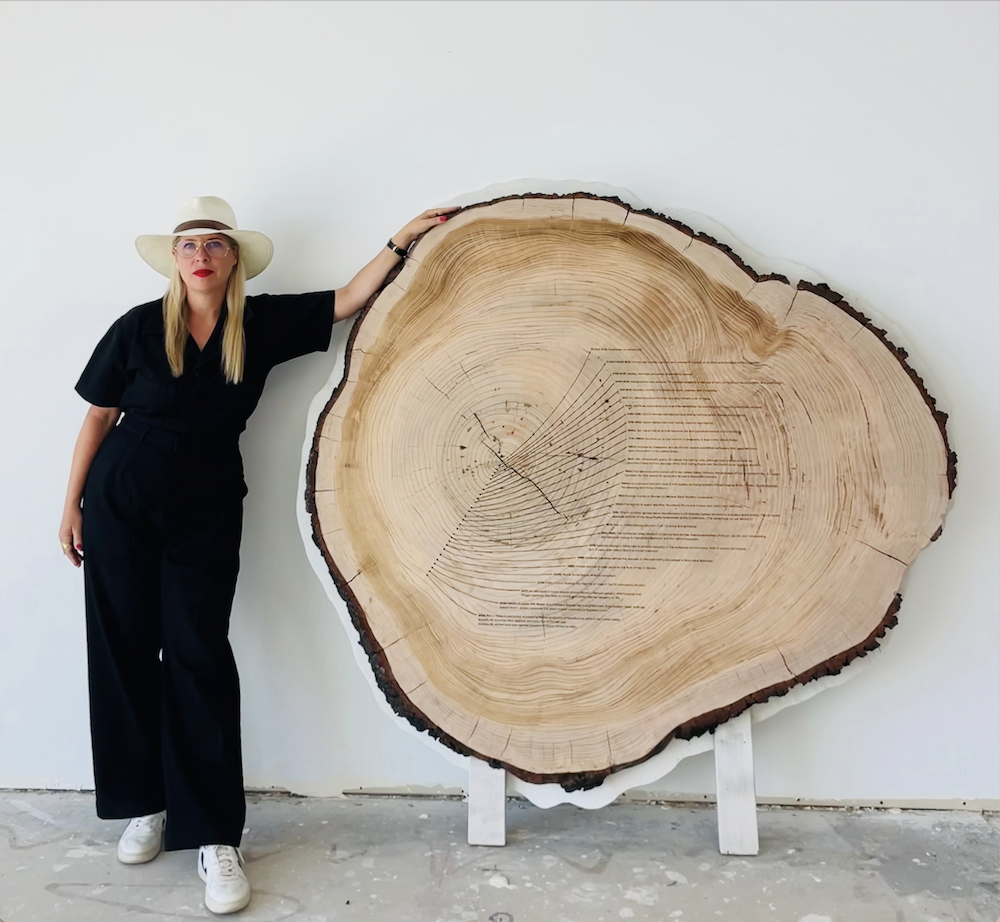On display from Nov. 1-4 in Washington, D.C., Tiffany Shlain’s Dendrofemonology remakes the historical tree ring into a timeline of the story of women and power in society.

The architecture of Washington, D.C., was self-consciously designed to evoke power, permanence and ancient Greek and Roman ideals of democracy and liberty, as espoused by the Founding Fathers. However, with erosion threatening architectural and human rights landmarks, artist and activist Tiffany Shlain says it is time to imagine a new national monument. Sponsored by the National Women’s History Museum and Women Connect4Good, she has undertaken such a project.
Shlain, a veteran commentator on the modern human condition, is orchestrating a moveable monument on the national mall: a tree ring roughly five feet in diameter, with text burned into the wood showing a timeline of the story of women and power in society.
Her ambitious take on the historical tree rings was inspired by her childhood visits to national parks. This ring begins by noting that goddesses were worshipped in 50,000 BCE. It ends with the outermost ring demarcating the 2022 overturning of Roe v. Wade as “eviscerating federal protection of reproductive rights in the U.S.” (See a full list of the tree ring’s milestones at the end of this article.)
Shlain’s feminist history tree ring is named Dendrofemonology, a play on the term dendrochronology—the science of “dating events in former periods by the comparative study of growth rings in trees.” It offers an intentional counternarrative to more typical patriarchal fare—such as narratives that credit colonialist Christopher Columbus for setting sail in 1492, as the Cross-Section of Time landmark does at Muir Woods National Monument, an example of what Shlain calls “mansplained history.”
The feminist history tree ring will be on display from Nov. 1-4, 2023, between the Washington Monument and the imposing Capitol building.
Unlike the stone structures that will tower over it on all sides, the tree ring is evocative of a once-living thing, majestic in its own right, that has witnessed history and aspires to be a part of correcting its oversights and injustices.
“I literally was finishing it as the Dobbs decision happened,” said Shlain of the project.
The Dobbs ruling “felt like a punch to the soul”—the same one she experienced in 2016 when she “thought we were going to get our first woman president.” After the 2016 election, she again turned to art as activism, creating a global event about gender equity called 50/50 Day in 2017, which featured a 20-minute film, “50/50: Rethinking the Past, Present and Future of Women + Power.”
As rights for underrepresented groups, never fully realized, are being threatened by a deluge of legal setbacks, Dendrofemonology offers itself as a bullseye for collective action. The concentric circles in its chronology point to eroding status and reproductive rights for women, mortally threatening their health and autonomy.
“We need a visual, and we need a coming together,” said Shlain of her motivation for the project, with the taglines #ReclaimOurHistory and #VoteOurFuture.
And what better place to come together than the U.S. capital, where federal laws are made and adjudicated—like the 2022 decision that overturned Roe v. Wade and the 2013 Shelby decision that dealt a devastating blow to voting rights. Both opened floodgates to further restrictive and reactionary state laws.
As the dendrofemonolgy event’s promotional materials attest, there are 93,000 races on the ballot across the country in November 2023 “that could affect women’s rights, trans rights, reproductive rights, and our climate,” so there are no off-years, no negligible races.
This art installation and rallying point on the National Mall is planned as a series of events raising awareness about what is at stake. It will include live and virtual events, live-streamed speakers, educational resources and a participatory component, in which people will be asked which tree ring entry most resonated for them and, more importantly, what entries they would like to see added to the remaining space on this new monument as history unfolds.
“I really am interested in this idea that monuments are made out of material that lasts too long … and I actually really loved this idea of this monument. It won’t last forever. And it’s moveable,” said Shlain of her tree ring project, which has been shown in San Francisco’s Ferry Building, where she was artist-in-residence in fall 2022, and will make its way around the country to D.C., New York and other cities in the years ahead.
“Whether the monuments and the history books don’t include women and people of all genders, we know that we exist, and our rights matter,” Shlain said. “Trees don’t lie … they are witnesses to history, of climate.”
According to Shlain, the widths of the rings are based on how much it rained or whether there was drought, wind or fires. This tree is about 250 years old. Shlain said she loves playing with the convention of tree rings equaling time, offering an alternative perspective and intersectional and feminist lens to look at the world.
Shlain’s career as a filmmaker, author and founder of the Webby Awards (aka the “Oscars of the Internet”) has evolved to this latest manifestation in the three-dimensional medium of sculpture. While Shlain still makes films, she said that she also liked the idea of the wood sculpture medium, which affords the opportunity to stand up close to and touch the artwork. “It’s got a real smell to it … the tactility of it is exciting to me.”
“In many ways trees give time a physical dimension,” said Shlain of the project. “I like the idea that it’s another medium, which always helps. We have to meet people wherever they are, through every imaginable angle. … I think that that is what I’ve been so excited about working in sculpture.”
Shlain said “the temple in the nature that we frequently went to growing up,” among the trees of Muir Woods and elsewhere, as foundational to her psyche. These memories eventually helped her innovate the tree ring timeline involving pyrographers burning text into the wood using that ancient art form and recalling the secular sanctuary of her youth.
D.C. edifices were designed to appear as though they will endure, like the general welfare and blessings of liberty that the U.S. Constitution professes to secure for posterity. But backsliding on rights once thought secured, like reproductive and voting rights, suggests cracks in these façades. Symbolically, even the seawalls surrounding D.C.’s Tidal Basin, home of its iconic cherry blossoms, are now deemed “unfit to protect the land surrounding them from rising water levels driven by climate change.”
Interjecting this tree ring timeline as a feminist focal point and symbol of nature among man-made monuments invites a coming together of affected groups to reclaim their history and safeguard their rights through the power of the vote. The exhibit intends to bring balance by fully representing collective voices and identities. It offers the best hope of safeguarding the foundations of democracy and environmental integrity against the current existential threats.
Shlain hopes the tree rings will galvanize action and underscore interdependence and shared solutions, such as supporting efforts to enshrine the ERA as a constitutional amendment to secure women’s and LGBTQ+ rights.
What the tree ring says from top line downward:
- 50,000 BCE: Goddesses are worshiped.
- 10,000-3000 BCE: Women are healers, shamans, and warriors. A number of societies acknowledge multiple genders.
- 3100 BCE: Literacy develops, and seeds of patriarchy spread.
- 2400 BCE: Mesopotamian law declares: “If a woman speaks to a man out of turn, her teeth will be smashed in by a burnt brick.”
- 200 BCE: Goddess worship is forbidden in Judaism, and later, in Islam and Christianity.
- 690: Wu Zetian becomes the first—and only—female ruler of China.
- 1100: Matrilineal and matriarchal Hopi tribe establishes the community of Oraibi in present-day Arizona.
- 1450 to 1918: 50,000 women tortured and executed as witches across Europe and America.
- 1576-1610: Queen Amina rules over Zazzau (present-day Nigeria).
- 1690s: Sor Juana Inés de la Cruz becomes the first published feminist in the Americas.
- 1776-1860s: Abortion up to four months of pregnancy is legal in the United States.
- 1880s: Inspired by indigenous and abolitionist leaders and British suffragists, first-wave feminism gains momentum in the United States.
- 1920: 19th Amendment grants U.S. women the right to vote, although most women of color are disenfranchised until the passage of the 1965 Voting Rights Act.
- 1920: The Soviet Union legalizes abortion.
- 1960: FDA approves birth control pill in the United States.
- 1960: Sirimavo Bandaranaike of Ceylon (present-day Sri Lanka) becomes the first woman to be elected to lead a democratic country.
- 1962: Dolores Huerta co-founds the U.S. National Farm Workers’ Association.
- 1960s: Second-wave feminism begins with leaders including Dorothy Pitman Hughes, Betty Friedan, Gloria Steinem, Flo Kennedy and Shirley Chisholm.
- 1963: First woman in space Valentina Tereshkova flies a solo mission and orbits Earth 48 times.
- 1972: Title IX in prohibits gender-based discrimination in U.S. federally-funded educational programs and activities.
- 1972: The U.S. Senate approves addition of the Equal Rights Amendment to the Constitution. (The states have not yet ratified it.)
- 1973: Roe v. Wade legalizes abortion in all U.S. states and territories.
- 1974-1980: The Combahee River Women’s Collective calls out the interconnectedness of sexism, racism and homophobia, and demands change in mainstream feminism and civil rights movement.
- 1975: Icelandic Women’s Strike held to protest inequality in the workplace and the home. Ninety percent of women participate, and 15 years later Iceland elects a woman president.
- 1989: Kimberlé Crenshaw defines the concept of intersectionality and ushers in third-wave feminism.
- 1993: Women allowed to wear pants on the floor of the U.S. Senate.
- 2006: Tarana Burke begins #MeToo movement.
- 2016: Hillary Rodham Clinton receives the majority of votes in the U.S. presidential election.
- 2017: An estimated 5 million people attend Women’s Marches globally. #MeToo goes viral.
- 2017: Oregon becomes first state to include nonbinary gender category on IDs.
- 2020-2022: U.S. elects first female vice president, Kamala Harris, and first trans state senator, Sarah McBride; Ketanji Brown Jackson becomes first Black woman confirmed to Supreme Court.
- 2022
- Roe v. Wade is overturned, eviscerating federal protection of reproductive rights in the United States.
- Globally, 65 countries have legalized abortions, four in the last year.
- Globally, 86 women have been elected president or prime minister to date.
Up next:
U.S. democracy is at a dangerous inflection point—from the demise of abortion rights, to a lack of pay equity and parental leave, to skyrocketing maternal mortality, and attacks on trans health. Left unchecked, these crises will lead to wider gaps in political participation and representation. For 50 years, Ms. has been forging feminist journalism—reporting, rebelling and truth-telling from the front-lines, championing the Equal Rights Amendment, and centering the stories of those most impacted. With all that’s at stake for equality, we are redoubling our commitment for the next 50 years. In turn, we need your help, Support Ms. today with a donation—any amount that is meaningful to you. For as little as $5 each month, you’ll receive the print magazine along with our e-newsletters, action alerts, and invitations to Ms. Studios events and podcasts. We are grateful for your loyalty and ferocity.





